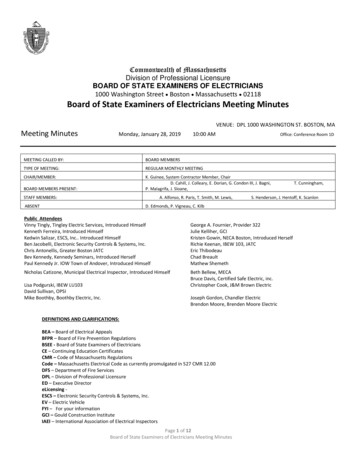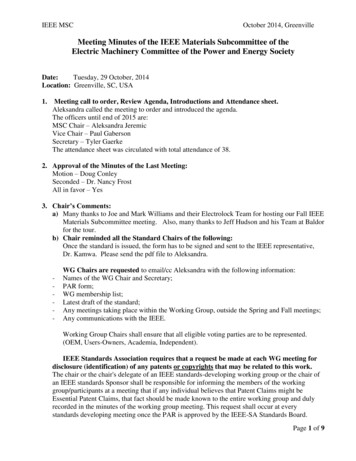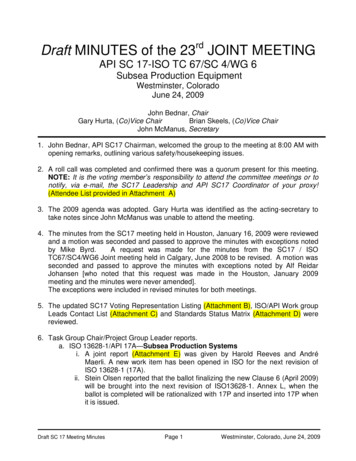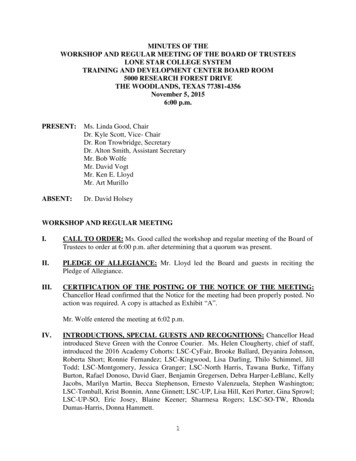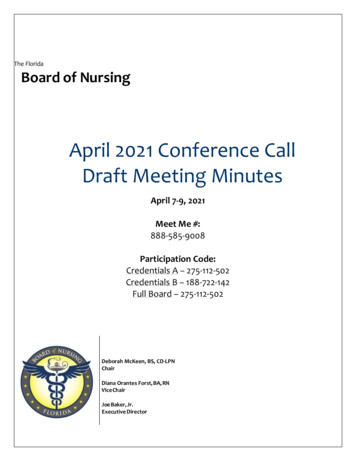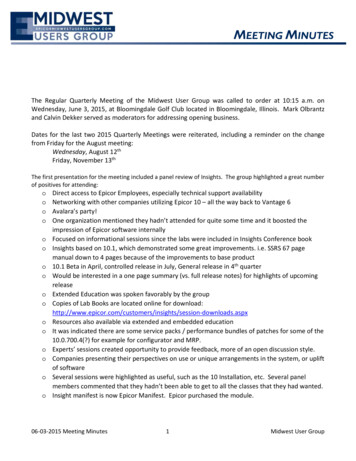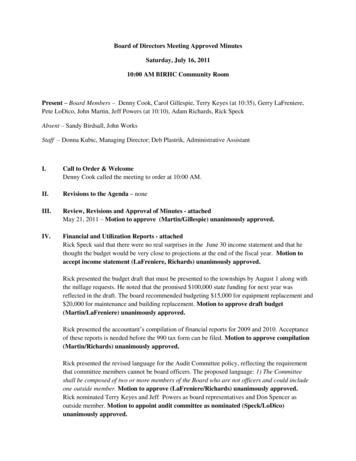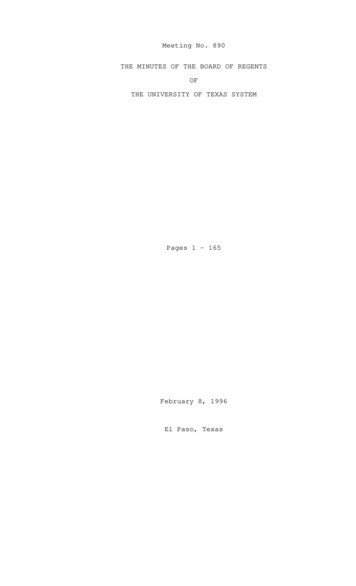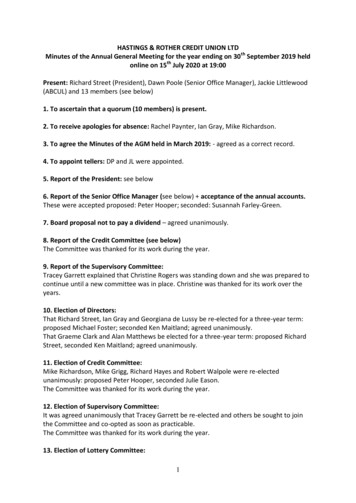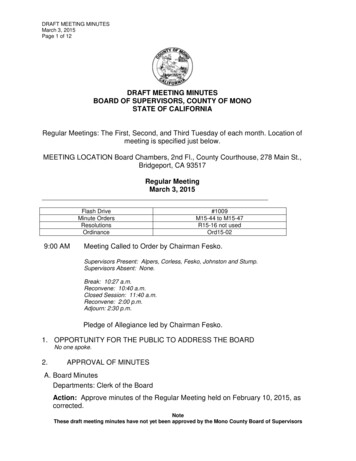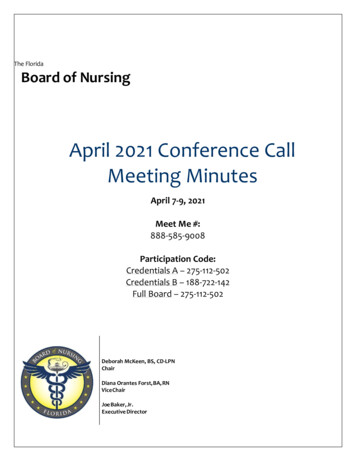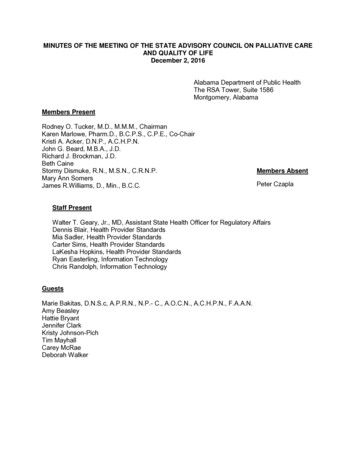
Transcription
MINUTES OF THE MEETING OF THE STATE ADVISORY COUNCIL ON PALLIATIVE CAREAND QUALITY OF LIFEDecember 2, 2016Alabama Department of Public HealthThe RSA Tower, Suite 1586Montgomery, AlabamaMembers PresentRodney O. Tucker, M.D., M.M.M., ChairmanKaren Marlowe, Pharm.D., B.C.P.S., C.P.E., Co-ChairKristi A. Acker, D.N.P., A.C.H.P.N.John G. Beard, M.B.A., J.D.Richard J. Brockman, J.D.Beth CaineStormy Dismuke, R.N., M.S.N., C.R.N.P.Mary Ann SomersJames R.Williams, D., Min., B.C.C.Members AbsentPeter CzaplaStaff PresentWalter T. Geary, Jr., MD, Assistant State Health Officer for Regulatory AffairsDennis Blair, Health Provider StandardsMia Sadler, Health Provider StandardsCarter Sims, Health Provider StandardsLaKesha Hopkins, Health Provider StandardsRyan Easterling, Information TechnologyChris Randolph, Information TechnologyGuestsMarie Bakitas, D.N.S.c, A.P.R.N., N.P.- C., A.O.C.N., A.C.H.P.N., F.A.A.N.Amy BeasleyHattie BryantJennifer ClarkKristy Johnson-PichTim MayhallCarey McRaeDeborah Walker
CONSIDERATION OF THE MINUTES OF AUGUST 12, 2016 (EXHIBIT “A”):The Council recommended approval of the Minutes of August 12, 2016, as distributed;the motion carried unanimously.INTRODUCTION OF NEW MEMBER:Dr. Geary welcomed Mary Ann Somers as a new Council member. Ms. Somers is aPatient and Family Caregiver Representative.REVIEW OF MISSION STATEMENT (EXHIBIT “B”):Dr. Geary informed the Council that the mission statement, which was approved at thelast meeting, is now located on the ADPH website under Health Provider Standards, PalliativeCare.ADPH VIDEO/WEBINAR EDUCATION DISCUSSION (EXHIBIT “C”):Ryan Easterling from the ADPH Information Technology unit gave a presentation on howthe unit can assist with any telecommunication needs the Council may have, including trainingvideos. He also described the different options the Council has for webinars, videobroadcasting both live and on demand, program marketing, and creating teaching tools toeducate people on palliative care. Mr. Easterling explained that once the material is created, itcan be viewed on YouTube and on the ADPH page through “on demand”. Dr. Tuckersuggested a narrative training video be made on the new Do Not Attempt Resuscitation (DNAR)Order form. Mr. Easterling agreed to work with Dr. Geary to get it created.REVIEW OF PC APP (EXHIBIT “D”):Dr. Tucker introduced Deborah Walker who discussed her Cancer Resources App,which provides helpful information for community cancer resources located within Alabama.The Cancer Resources App is geared towards the five counties in the Birmingham area. Theapp is available to download through Apple or Google Play. Dr. Bakitas, from the UAB Schoolof Nursing and School of Medicine discussed the Heart Care CHF App and how it can be linkedto palliative care through customization. Mr. Cooper, broadcasting from UAB, assisted-2-
Dr. Bakitas by demonstrating how the Heart Care CHF App is utilized. Ms. Walker andDr. Bakitas discussed linking Dr. Bakitas’s resources to the ADPH website and Dr. Tuckeragreed. Dr. Tucker recommended approval of the link to be added to the ADPH website; themotion was carried unanimously.BOOK DISCUSSION (EXHIBIT “E” – Book was distributed to the Council members):Dr. Tucker introduced Hattie Bryant to discuss her book I'll Have It My Way: TakingControl of End of Life Decisions: a Book about Freedom & Peace. Ms. Bryant discussed waysthe Council could customize and utilize her book as a teaching resource. Dr. Geary added thatdifferent groups could co-sponsor the book.NURSING HOME: PALLIATIVE CARE EFFORTS:Ms. Kristi Acker stated that health care providers are confused about what palliative carereally is. She explained that many providers have requested training on palliative care.Dr. Tucker and the Council discussed many ideas of what to produce as their first trainingresource video. Dr. Geary suggested someone from the Council speak at the State SurveyAgency Directors’ Meeting on January 31, 2017 – February 1, 2017, on palliative care.Kristi Acker and Richard Brockman expressed their interest in speaking at the meeting.ADDITIONAL MEMBER DISCUSSION (EXHIBIT “F”):The Council discussed the new DNAR form. The Council recommended approval of theform’s card stock to be changed to light pink and for it to be two pages; the motion carriedunanimously. Dr. Geary informed the Council that the form will be easily accessible by going tothe ADPH website, Laws/Regulations, Advance Directives/Portable Physician Do Not AttemptResuscitation Orders.NEXT MEETING DATE:The Council was informed that the date of the next meeting is Friday, February 10, 2017.Dr. Tucker informed the Council that topics for the next meeting should be sent to either him orDr. Geary.-3-
SUBSEQUENT MEETINGS:The upcoming meetings for 2017 will be as follows: Friday, May 12, 2017; Friday,August 11, 2017; and Friday, November 17, 2017.Rodney O. Tucker, MD, ChairState Advisory Council on Palliative Care and Quality of LifeWalter T. Geary, Jr., MDAssistant State Health Officer for Regulatory AffairsMedical ConsultantHealth Provider StandardsAlabama Department of Public Health-4-
EXHIBIT “A”STATE ADVISORY COUNCIL ON PALLIATIVE CARE AND QUALITY OF LIFEQUARTERLY MEETINGAUGUST 12, 201610 A.M.RSA TowerBoard Room 1586Montgomery, ALMembers Present:Kristi A. Acker, D.N.P., A.C.H.P.N. - University of Alabama DCH Cancer CenterJohn G. Beard, M.B.A., J.D., President - Home Care Association of AlabamaRichard J. Brockman, J.D. - Alabama Nursing Home AssociationBeth Caine - Alabama Hospital AssociationStormy Dismuke, C.N.O. - Alabama Hospice and Palliative Care AssociationKaren Marlowe, Pharm.D., B.C.P.S., C.P.E., Co-Chair - Alabama PharmacyAssociationRodney O. Tucker, M.D., M.M.M., Chairman - UAB Center for Palliative andSupportive CareJames R. Williams, D., Min., B.C.C. - Baptist Medical Center SouthPeter Czapla – Alabama Durable Medical Equipment AssociationBureau of Health Provider Standards Staff:Walter T. Geary, Jr., M.D., Bureau Director/Medical DirectorDiane Mann, HR Director/Project LiaisonLaKesha E. Hopkins, M.S.H.R.M., Assistant to HR DirectorDr. Tucker called the meeting to order. He thanked everyone for coming and asked if anyonehad any comments on the minutes from the last meeting. There were none. He then asked for amotion to have them approved. The minutes were approved and there were no corrections oradditions necessary.The first item on the agenda was the linkage to additional national websites in regards topalliative care. Dr. Tucker referenced to the voting on the website linkage that was discussedduring the last meeting. The Council voted that there will be links to all of the websites thatwere suggested during the May 13, 2016 meeting. In addition to those links, Dr. Tucker wouldalso like for the Council members to view HPNA.org and vote during the next meeting onwhether or not that link will also be placed on the website.Dr. Tucker asked if there were any pharmacies or nursing homes that have a link of anythingpertaining to palliative care on their website. Mr. Brockman stated he knows they have a linkand that he would check on the nursing home side. Dr. Tucker recommended that if anyone hadany links from the Hospitals or Nursing Home Association regarding palliative care that wouldbe considered good resources, please share them with the Council. Dr. Tucker added any
MinutesPage 2August 12, 2016information on medication related topics in regards to palliative care or FAQs (frequently askedquestions) can also be considered for linkage.The next topic was the discussion of the Council’s Mission Statement. Dr. Geary accepted thetask of writing the new Mission Statement and Dr. Tucker asked him to discuss it with theCouncil. Dr. Geary distributed a handout with the Mission Statement that he created and the onethat was taken directly from the Act. He explained that he wanted to make the statement morepersonable and wanted suggestions and comments from the Council. Once the statements werereviewed, Peter Czapla stated that he thought Dr. Geary had done a very good job with the onehe created. Dr. Tucker agreed and stated that the next problem would be what to do about theeducation program. He commented that we are establishing the website, bringing in consumerinformation in a standardized way, and accessing ADPH. The next step is to educate through thedepartment about palliative care. This will probably be our mission for 2017. Ms. Marloweinterjected, “After reading the statement, we should have established an information piece.” Shewent on to say “We’re going to provide education and perhaps the Council is the way to create anetwork.” Dr. Geary commented that one problem with the department being responsible toeducate people is that none of us hold ourselves as experts. Therefore, it will be difficult to beable to present that from a variety of different perspectives as experts. There was discussionabout the language in the Act and Dr. Geary felt that the legislature wants physicians and nursesto be more in tuned with what palliative care is. Dr. Tucker commented that he was fine with theMission Statement the way it is. Dr. Tucker stated that maybe the Council should targetprofessional organizations as part of their educational program. Dr. Geary pointed out that wemight be able to use the Department’s Video Communication team to make short videos in orderto educate the public and reach a younger audience as well. Dr. Tucker asked if it would bepossible for them to come to the next Council meeting and show examples of their work.Dr. Geary said that he was sure they would. Dr. Tucker suggested that maybe the ADPH VideoCommunication Department would like to look at some of the videos that Palliative Care hasmade to get an idea of what is being discussed.Dr. Tucker inquired if there were any other comments about the Mission Statement.Mr. Brockman suggested that the Mission Statement should be changed to the following:The mission of this Council is to promote Palliative Care in Alabama and by improvingconsumer awareness of the positive effect of compassionate palliative care on the quality of lifeand care for individuals and families living with life-limiting illness.This will be accomplished through establishment of a consumer and professional informationand educational program within the Department of Public Health; and by facilitatingcollaboration among palliative care providers, organizations, institutions and individuals.The entire committee reviewed the changes and agreed that the statement was clear, concise, andthe goal of the Council. The changes were voted on, a motion was made, it was seconded and thenew Mission Statement was approved.Kristi Acker covered the next topic of discussion, nursing homes and palliative care. She statedthat she has called facilities in the nursing home community and has found that they just opened
MinutesPage 3August 12, 2016the door for palliative care. However, it is mostly geared towards the end of life, not so muchpalliative care. Dr. Tucker stated that he was interested in knowing what happens to a patient inthe nursing home as they deteriorate; terminal. Mr. Brockman discussed the requirements of anursing home regarding advanced directives and short-term stay. There are really two phases forpatients coming into a nursing home; episodic care and transformation. Mr. Brockman discussedhow during the care plans phase palliative care, quality of life and end of life can be discussedwith patients and their families. Dr. Tucker asked Ms. Acker what she meant by nursing homesare being open to palliative care. Ms. Acker commented that they were open to the in-servicesand training staff. She went on to say that she would like to make two points. First, the nursinghomes do an excellent job in communication and pulling together resources. Secondly, therehabilitation phase is where palliative care should be introduced. There is not really anythingoutside of the hospice model and the top concern is developing a network. Ms. Acker added thatthe top concern that she sees is helping communities develop a network of interdisciplinary teammembers.Mr. Brockman stated that one thing to have is an integrated care network. This is a team thatfollows a patient all the way through, in every setting, regardless if they go home or stay in afacility. Dr. Tucker interjected that this was getting into our additional member discussion whichis good because it helps us all be informed. Dr. Tucker stated that what they see on the hospitalside is the transitioning into the two groups. They look at their visit as a benchmark and possiblysomething else happens to the patient enough times that they have to go into skilled nursing.Even if patients go into rehab and have a DNR while there in the hospital, there are a lot ofproblems as to whether that DNR is honored in a nursing home even though they have it in thehospital. Even when they’re told they’re better and can go home, there are still issues about staffdiscussing the DNR. However, when a patient goes into long-term care, different conversationstake place, because the needs of the patient become different. The part of palliative care that canmake a difference in the nursing home are communication and goals of care.Dr. Geary asked if there was a national link to palliative care regarding nursing homes and if sowhat should we look for. Dr. Tucker stated there has been a lot of research done on that subject.Mr. Brockman commented that there is a probably information that we can look at. There wasmuch discussion surrounding DNRs and how they are highly misunderstood. Dr. Tuckerconcluded that through this discussion the Council was able to see all the different complexitiesfrom our vantage point and he considers palliative care the glue that holds everything alltogether.Mr. Czapla continued the discussion about how patients are placed in a nursing home becausethey need “a place to go,” and how a lot of them are taken to rehab for 21 days for that samereason. Ms. Marlowe stated because families don’t have “a place for them to go” until thefamily can get some other benefit justified. Ms. Dismuke stated she has two concerns. First,when individuals visit the website, what is available to them in Alabama? She believes thereshould be a list for each entity on what they offer regarding palliative care. Dr. Tuckercommented that Dr. Bakitas explained the “Heart” app could be converted and used as a resourcefor Alabama. The app has been previously converted and has three applications. Ms. Dismuke’ssecond concern is educating staff on getting medications to hospice patients. Ms. Marloweagreed that facilities are interested in educating on medications and assessments. She went on to
MinutesPage 4August 12, 2016state that facilities are aware they need the education, but what can be done about it.Mr. Brockman referenced a convention that will be held in September and asked Ms. Marlowe tomake a presentation on the early state of palliative care in nursing homes. Dr. Tucker stated thatthe Council will revisit the subject of palliative care in nursing homes at a later date.Dr. Tucker also made reference to Hattie Bryant, the author of I’ll Have It My Way: TakingControl of End of Life Decisions: a Book about Freedom & Peace, and reminded the Councilthat she is an advocate for patients. He would like to invite her to the next meeting to make apresentation. Also, Dr. Tucker would like to further discuss the “Heart” app and perhaps havethe UAB School of Nursing on the phone and the ADPH IT Department present to discuss usingthe short videos to promote palliative care.Dr. Geary began a discussion on the form for DNRs. He stated that once the DNR form is in thechart, it serves as the documentation across all entities. This will solve a lot of problems withpatients that are terminal and being transferred. Mr. Brockman said a subset of this is that itbrings respect to this form and you have to use it and not do anything else. Dr. Geary interjectedthat now only one physician has to sign the form. He went on to say that people do notunderstand that by not making a decision, they are really making a decision. Dr. Tucker askedDr. Geary if the form has been approved. Dr. Geary commented that the form goes before theState Committee on October 3, 2016 and if approved, will become a rule unless there is sometype of challenge. Dr. Miller would like for Dr. Geary to make a presentation to the HospitalAssociation regarding the DNR form. Dr. Tucker thinks the DNR form is a big improvement.Mr. Brockman agreed, it’s a huge load off everyone’s mind. Dr. Geary commented that thedepartment will not be surveying this form. The burden is on the rules. Ms. Marlowe stated thatwe are heading in the right direction. Communicating with the family is the best thing to do andfamilies are finally being heard.The discussion continued in regards to DNRs until Dr. Tucker adjourned the meeting. The nextmeeting will be on December 2, 2016, at 10 a.m., at the RSA Tower, in Board Room 1586located at 201 Monroe St., Montgomery, AL 36104.
EXHIBIT "B"
EXHIBIT "E"
EXHIBIT “F”Alabama Portable Physician Do Not Attempt Resuscitation OrderNo CPR/ Allow Natural DeathPatient/Resident Full Name (PRINT) and Date of Birth:Instructions. This order is valid only if Section I, II, III, OR IV is completed AND aphysician has completed Section V.Section I. Patient/Resident Consent.I, the undersigned patient/resident, direct that resuscitative measures be withheldfrom me in the event of cardiopulmonary cessation. I have discussed this decision withmy physician, and I understand the consequences of this decision.Signature of Patient/ResidentDateSection II. Incompetent Patient/Resident with DNAR instructions in Advance Directive.The patient/resident is not competent or is no longer able to understand,appreciate, and direct his/her medical treatment and has no hope of regaining thatability. A duly executed Advance Directive for Health Care with instructions that no lifesustaining treatment be provided was previously authorized by the patient/resident andis part of his/her medical record.Signature of provider or facility representativePrint NameDateSection III. Health Care Proxy or Attorney-in-Fact Consent.I, the undersigned, am the health care proxy or attorney-in-fact designated by thepatient/resident to make decisions regarding the providing, withholding, or withdrawalof life-sustaining treatment for the patient/resident. I hereby direct that resuscitativemeasures be withheld from the patient/resident in the event of cardiopulmonarycessation. A copy of the proxy or attorney-in-fact designation (e.g., living will, power ofattorney, etc.) has been made part of the patient/resident’s medical record.Signature of Proxy or Attorney-in-FactPrint NameDatePage 1 of 2
Section IV. Surrogate Consent.I, the undersigned, am the surrogate certified to make decisions, in consultationwith the attending physician, regarding the providing, withholding, or withdrawal of lifesustaining treatment for the patient/resident. After consultation with the attendingphysician, I hereby direct that resuscitative measures be withheld from thepatient/resident in the event of cardiopulmonary cessation. I believe that this decisionconforms as closely as possible to what the patient/resident would have wanted. I makethis decision in good faith and without consideration of the financial benefit or burdenwhich may accrue to me or to the health care provider as a result of this decision. A copyof the Certification of Health Care Decision Surrogate has been made part of thepatient/resident’s medical record.Signature of SurrogatePrint NameDateSection V. Physician Authorization.Based on the information above, I hereby direct any and all medical personnel,emergency responders, and paramedical personnel to withhold resuscitative measures,i.e., cardiopulmonary resuscitation, chest compression, e
Dec 02, 2016 · Walter T. Geary, Jr., MD, Assistant State Health Officer for Regulatory Affairs . Dennis Blair, Health Provider Standards . Mia Sadler, Health Provider Standards . of Nursing and School of Medicine discussed the Heart Care CHF App and how it can be linked to palliative care through customization. Mr. Cooper, broadcasting from UAB, assisted
